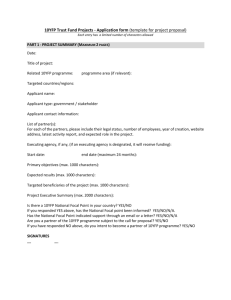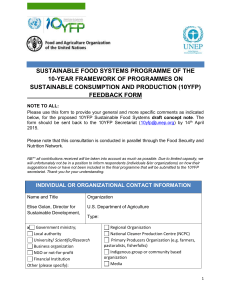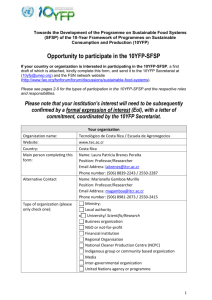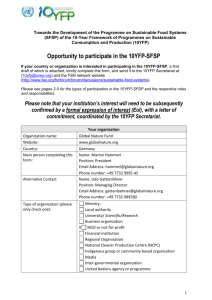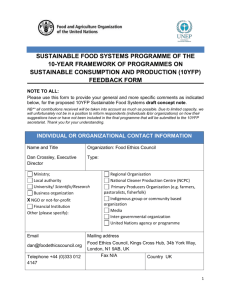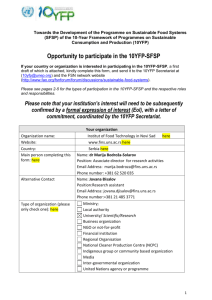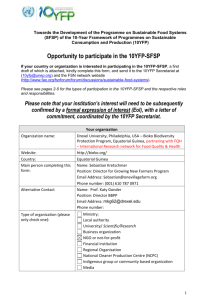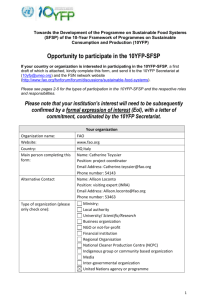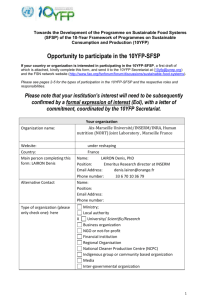Guidance document
advertisement
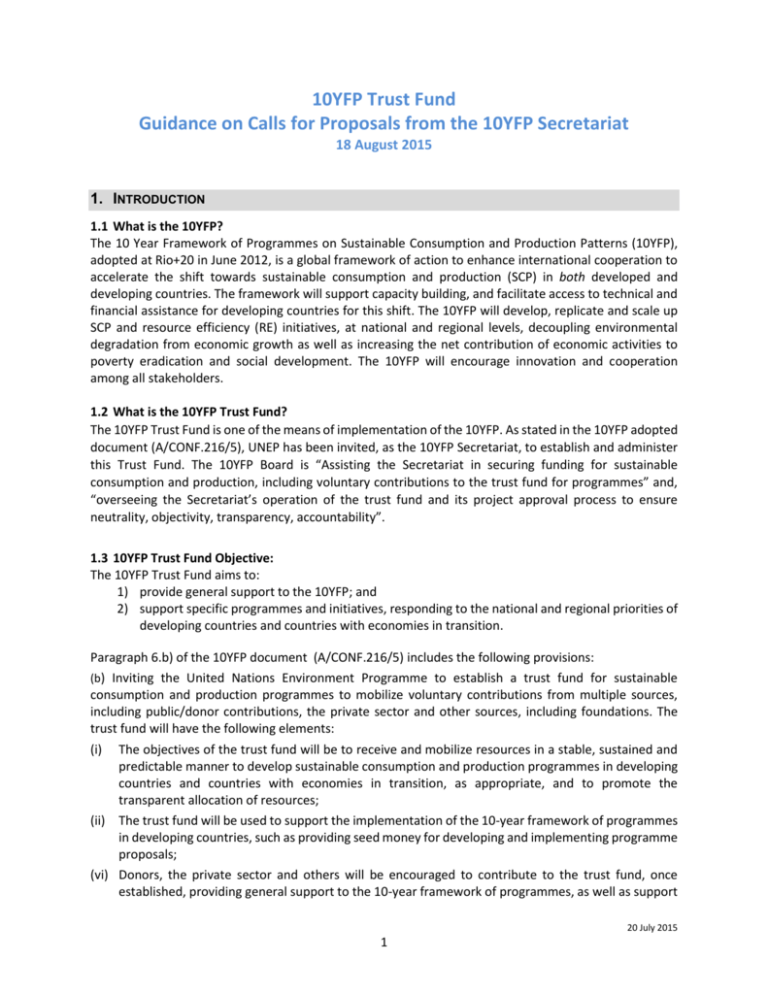
10YFP Trust Fund Guidance on Calls for Proposals from the 10YFP Secretariat 18 August 2015 1. INTRODUCTION 1.1 What is the 10YFP? The 10 Year Framework of Programmes on Sustainable Consumption and Production Patterns (10YFP), adopted at Rio+20 in June 2012, is a global framework of action to enhance international cooperation to accelerate the shift towards sustainable consumption and production (SCP) in both developed and developing countries. The framework will support capacity building, and facilitate access to technical and financial assistance for developing countries for this shift. The 10YFP will develop, replicate and scale up SCP and resource efficiency (RE) initiatives, at national and regional levels, decoupling environmental degradation from economic growth as well as increasing the net contribution of economic activities to poverty eradication and social development. The 10YFP will encourage innovation and cooperation among all stakeholders. 1.2 What is the 10YFP Trust Fund? The 10YFP Trust Fund is one of the means of implementation of the 10YFP. As stated in the 10YFP adopted document (A/CONF.216/5), UNEP has been invited, as the 10YFP Secretariat, to establish and administer this Trust Fund. The 10YFP Board is “Assisting the Secretariat in securing funding for sustainable consumption and production, including voluntary contributions to the trust fund for programmes” and, “overseeing the Secretariat’s operation of the trust fund and its project approval process to ensure neutrality, objectivity, transparency, accountability”. 1.3 10YFP Trust Fund Objective: The 10YFP Trust Fund aims to: 1) provide general support to the 10YFP; and 2) support specific programmes and initiatives, responding to the national and regional priorities of developing countries and countries with economies in transition. Paragraph 6.b) of the 10YFP document (A/CONF.216/5) includes the following provisions: (b) Inviting the United Nations Environment Programme to establish a trust fund for sustainable consumption and production programmes to mobilize voluntary contributions from multiple sources, including public/donor contributions, the private sector and other sources, including foundations. The trust fund will have the following elements: (i) The objectives of the trust fund will be to receive and mobilize resources in a stable, sustained and predictable manner to develop sustainable consumption and production programmes in developing countries and countries with economies in transition, as appropriate, and to promote the transparent allocation of resources; (ii) The trust fund will be used to support the implementation of the 10-year framework of programmes in developing countries, such as providing seed money for developing and implementing programme proposals; (vi) Donors, the private sector and others will be encouraged to contribute to the trust fund, once established, providing general support to the 10-year framework of programmes, as well as support 20 July 2015 1 to specific programmes and initiatives responding to the national and regional priorities of developing countries. 1.4 Trust Fund calls for proposals Calls for proposals will take place at least once a year, pending funds availability. Calls may be focused on the six 10YFP programmes, and any additional programme established with the approval of the 10YFP Board, or on cross-cutting SCP activities for the overall implementation of the 10YFP. The 10YFP Secretariat, with the support of the Board, prepares calls for proposals, with relevant information on focus areas, required elements and templates. Calls are prepared with reference to the adopted text of the 10YFP, and with inputs from the lead/co-lead actors and Multistakeholder Advisory Committees (MAC) of the relevant 10YFP Programme(s). The 10YFP Secretariat announces calls for proposals on the 10YFP website (www.unep.org/10YFP/trustfund), the Global SCP Clearinghouse website (www.scpclearinghouse.org/d/other/80-10yfp-trust-fund-application-form.html), announcement through the 10YFP Newsletter and through National Focal Points. Announcements include: title, finance available, deadline for applications, and any other relevant information on the calls. The 10YFP Secretariat posts the calls for proposals for a period of 2 months. During that period, the 10YFP Secretariat can guide applicants and provide feedback on draft proposals if requested. 2. DESCRIPTION & DEFINITIONS 2.1 Description. This document outlines the process for developing, reviewing, approving, implementing, reporting, monitoring and evaluating projects submitted to the Trust Fund. 2.2 Definitions. In this document, the following definitions apply: 10YFP Programmes: These programmes contribute to further promoting and implementing the 10YFP and SCP projects. They bring together existing initiatives and partnerships working in similar areas, building synergies and cooperation between stakeholders to leverage resources towards mutual objectives and minimizing duplication of efforts. The six current 10YFP Programmes are consumer information; sustainable lifestyles and education; sustainable public procurement; sustainable buildings and construction; sustainable tourism, including ecotourism; and sustainable food systems. Additional programmes will be added, based on formal requests from governments and a set of selection criteria established with the Board. These programmes will provide technical guidance for the Trust Fund calls for proposals focused on their respective areas or sectors and related projects. Project proposals: project proposals are based on a template provided by the 10YFP Secretariat for the project description, related budget and all other documentation required. The project proposals are submitted for consideration. If they are selected, detailed project documents will be requested from the applicants. 10YFP Trust Fund Project: is the project proposal selected, and supported by the full project document. 20 July 2015 2 Applicant: the entity submitting a project to the Trust Fund. Any regional, national, local Governmental institution / agency (or subsidiary body) from a developing country or not-for profit1 civil society, scientific or technical organisations, with headquarters in developing countries2 and countries in transition. For profit organizations cannot apply. When a project proposal is selected to receive funding from the 10YFP Trust Fund, the applicant is the authorized signatory to contract agreement and, unless an executing agency has been designated by the applicant, is responsible for the use of the allocated funding according to the terms of the agreement and the approved project implementation plan. Executing agencies: it is an entity which can optionally be designated by the applicant to implement the project. Executing agencies can be: UN Agencies and other inter-governmental organisations (IGOs), notfor-profit organisations, governmental institutions / agencies3 from developing and developed countries. For profit organizations cannot be designated as executing agencies. When an applicant designates an executing agency to implement a project selected to receive funding from the 10YFP Trust Fund, the executing agency is the authorized signatory to contract agreement and is responsible for the use of the allocated funding according to the terms of the agreement and the approved project implementation plan. Lead Actor / Multi-stakeholder Advisory Committee (MAC) of 10YFP programmes: group of entities leading a specific 10YFP Programme, providing strategic direction, following its activities and contributing to its implementation. For each 10YFP Programme, a lead actor and/or co-leads are identified and the MAC is established. 1 Not-for-profit civil society organisations, scientific and technical organizations refer to: associations, NGOs, universities, scientific or technical organizations, and Community Based Organisations 2 For developing countries please refer to the following list: http://www.oecd.org/dac/stats/documentupload/DAC%20List%20of%20ODA%20Recipients%202014%20final.pdf; For economies in transition economies please refer to the following document: http://www.un.org/en/development/desa/policy/wesp/wesp_archive/2015wesp_full_en.pdf. 3 If the governmental institution is from a developed country, this institution should provide co-funding for at least 20% of the total amount of the proposal, and the proposal should include a capacity building element. 20 July 2015 3 2.3 Timeline for Calls for proposals (illustrative timeline, based on sections 3 to 7). 20 July 2015 4 PROJECTS CHARACTERISTICS AND ELIGIBILITY 2.4 Project Characteristics: Duration: From a minimum of 12 months to up to maximum of 24 months Amount: Indicated in the call for proposal, with a minimum amount disbursed by the Trust Fund of USD 100k per project. Objectives: Responding to the SCP priorities and needs of developing countries and countries with economies in transition, advancing the shift to SCP, fulfilling the 10YFP goals, vision and principles, and contributing to the implementation of the relevant 10YFP programme. Project proposals can only be carried out and submitted by one applicant, including in the case of multi-country project proposals. An applicant can designate only one executing agency to implement the project. 2.5 Eligibility Eligibility as applicants and executing agency Only regional, national, local Governmental institution / agency (or subsidiary body) from developing countries or not-for profit4 civil society, scientific or technical organisations, with headquarters in developing countries5 and countries in transition are eligible to be applicants to the Trust Fund. Only UN Agencies and other inter-governmental organisations (IGOs), not-for-profit organisations and governmental institutions / agencies from developed and developing countries are eligible as executing agencies. An executing agency must be commissioned by an applicant to implement the project. When the executing agency is from a governmental institution from a developed country, this institution is expected to provide co-funding to the project for at least 20% of the total proposal, and the proposal should include a capacity-building element. To be considered eligible, a project proposal submitted by an applying government institution/agency shall be submitted to the Secretariat, after having been consulted with the 10YFP National Focal Point(s) of their country-ies. Evidence that the NFP has been consulted needs to be provided together with the application. When a 10YFP National Focal Point has not been nominated in the country of the applying government institution/agency, the project proposal shall be submitted to the 10YFP Secretariat directly; To be considered eligible, a project proposal submitted by a not-for-profit organisation, shall be submitted directly to the 10YFP Secretariat, with a mandatory copy to the 10YFP National Focal Point of their country. When a 10YFP National Focal Point has not been nominated in the country of the applying not-for-profit organisation, the project proposal shall be submitted to the 10YFP Secretariat directly. Not-for-profit consist of: associations and non-governmental organizations (NGOs), universities, scientific or technical organizations, and Community Based Organisations (CBOs). 2.6 Scope/location: 4 Not-for-profit civil society organisations, scientific and technical organizations refer to: associations, NGOs, universities, scientific or technical organizations, and Community Based Organisations 5 For developing countries please refer to the following list: http://www.oecd.org/dac/stats/documentupload/DAC%20List%20of%20ODA%20Recipients%202014%20final.pdf; For economies in transition economies please refer to the following document: http://www.un.org/en/development/desa/policy/wesp/wesp_archive/2015wesp_full_en.pdf. 20 July 2015 5 The project’s geographical scope may be at the national (including sub-national), sub-regional or regional level or include multi-country projects, for developing countries/countries with economies in transition. The specific programme call for proposals may also establish thematic priorities for the scope of work. 3. PROPOSAL SUBMISSION : HOW TO APPLY? 3.1 Preparing the Application: The application template of Annex 1 and provided on the 10YFP website (http://www.unep.org/10yfp/ActorsStructure/TrustFund/tabid/106253/Default.aspx) is the official document for submitting project proposals. Applicants should complete the template online in accordance with the instructions included in this guidance document (especially project characteristics) and the specific call they are responding to. In case the applicant encounters problems with filling the online template the Word version of the application form may be completed by the applicant and submitted with the relevant annexes (budget, information form, supporting documents) to 10yfp@unep.org. All applications must be submitted in English. To be considered fully responsive, all fields of the application must be completed, and any requested supporting documentation must be included in the application and submitted by the stipulated deadline. If the project is selected, the applicant will be required to develop a full project document. The template for the full project document will be provided to the selected applicants. As indicated in section 3.2 on eligibility, proposals developed by governmental institutions/ agencies are submitted to the Secretariat after informing and consulting the National Focal Point(s) 6 of their country-ies – if nominated - together with evidence of such consultation. Proposals developed by not-for-profit organisations are sent directly to the 10YFP Secretariat, with a mandatory copy to the relevant NFPs of their country – if nominated7. 3.2 Interlocutor The 10YFP Secretariat is the main interlocutor for applicants for matters such as: Trust Fund administration, calls for proposals coordination and management, review, evaluation and selection process of submitted proposals, contractual arrangements for selected proposals, monitoring project implementation, receiving and reviewing progress and final reports, reporting to the 10YFP Board. 4. PROPOSAL SELECTION PROCESS 4.1 Criteria: Criteria for evaluating proposals are developed by the Secretariat together with the 10YFP Board, with technical inputs from the 10YFP programmes. They ensure that projects funded contribute to the implementation of the 10YFP and its programmes. They also require clear indicators to measure progress. These criteria can be periodically revised, but must be based on the 11 criteria in paragraph 7 of the 10YFP adopted document. (See annex 2) 6 National Focal are nominated by Governments “for engagement with the 10YFP, with a view to ensuring contact and coordination with the board and the secretariat”. A list of NFPs can be found at: http://www.unep.org/10yfp/Portals/50150/downloads/National%20Focal%20points%20directory%20for%20web %20280814.pdf 7 The 10YFP Secretariat will send, to each concerned NFP, a summary list of all proposals received for their country (3 days after the call for proposal deadline). 20 July 2015 6 Review process: The 10YFP Secretariat reviews proposals for completeness and ensures the proposals address and comply with the 11 criteria, using a common rating matrix developed by the Secretariat, validated by the 10YFP Board, and made available on the 10YFP website. (2 weeks) In the meantime, leads/co-leads actors and Multi-Stakeholder Advisory Committee(s) (MACs) of related 10YFP Programme(s) 8 are requested to review eligible proposals they have received from the 10YFP Secretariat against the technical criteria that are indicated in the calls for proposals. The leads/co-leads and MAC members collectively rate all proposals received from the Secretariat according to defined technical criteria, using a common rating matrix developed by the Secretariat. This rating may be provided to the Board upon Board’s request. Based on this evaluation, the leads/co-leads and MACs provide feedback on proposals, and recommendations for a rating and a short list of eligible project proposals (2 to 3 weeks depending on the number of applications received). In the case of calls for proposals cutting across the different programmes, a project review committee can be composed of the leads/co-leads and MAC members of the relevant programmes. Based on the combined evaluation by the 10YFP Programme’s leads/co-leads and MAC members against technical critieria and by the Secretariat against the 11 criteria, the Secretariat prepares a short list of eligible proposals. (3 days) The Secretariat undertakes due diligence for all eligible proposals, based on information provided by the applicant and, when relevant, the executing agency. (3 days) The Secretariat submits both the list of all submissions and short listed project proposals (with reservations on compliance to UN rules), taking into account the need for regional and stakeholder balance, including the details and results of the evaluation to the Board, to be approved. (2 days) The 10YFP Board selects and / or approves based on the overall rating and evaluation of eligible projects, provided the full project document and related budget later submitted to the 10YFP Secretariat are compliant with UN rules and regulations. (2 weeks) 4.2 Conflict of interest: Any Programme Leads /co-Leads, members of a programme Multi-stakeholder Advisory Committee and members of the 10YFP Board intending to have any involvement in a specific call for proposals (ie as applicant, executing agency, partner or co-funder of a project proposal), must declare their interest to the 10YFP Secretariat and must recuse themselves from participating in any stage of this call for proposals (development and selection process). Programme Lead/co-lead, members of a programme Multi-stakeholder Advisory Committees and members of the 10YFP Board cannot render a recommendation on a proposal that originates from an applicant based in their country. If a Programme Lead /co-Leads, members of a programme Multistakeholder Advisory Committee and members of the 10YFP Board is indicated by the applicant as a 8 Each programme decides on its governance to screen projects, as long as they are screened in an inclusive manner. It could be therefore screened by a sub-group of the MAC members, if the programme so decides. 20 July 2015 7 partner in a project proposal, but was not informed by the applicant, it should recuse him/herself from rendering a recommendation on that proposal. 5. SELECTION OF PROPOSALS, FULL PROJECT DOCUMENTS, AND DISBURSEMENT OF FUNDS 5.1 Selection and information of applicants and development of full project documents: Selected and not selected applicants are informed by the 10YFP Secretariat about the result of the evaluation of their proposal. Applicants of selected proposals must submit a full project document within 2 months, which will be reviewed by the 10YFP Secretariat (Lead/co-lead and MAC members can be called in by the Secretariat for technical support if need be): o 6 weeks after the information to applicants of selected proposals, the 10FYP Secretariat is available to provide advice on an advanced draft project document. o The Secretariat may revert to applicants to ensure UN rules and regulations are applied, and that the full project document is in line with the approved project proposal and budget. The applicant (and if possible also all other project partners) will become a partner of the 10YFP Programme. 5.2 Contractual arrangements and disbursement: The 10YFP Secretariat is responsible for making contractual arrangements using UNEP legal instruments, and will disburse approved funding from the 10YFP Trust Fund, based on a cleared project document and signed legal agreement. Legal instrument templates used to disburse funds will be provided by UNEP. Disbursements will be made according to the schedule specified in the legal agreement i.e. based on reception of 6 monthly progress and financial reports. The first disbursement will be made upon signature to ensure start of implementation. The final disbursement will be made after completion of the project, ie when completion has been confirmed by the Secretariat’s evaluation of the final progress and financial reports. 6. PROJECTS REPORTING, MONITORING AND EVALUATION Project progress and final reports (both narrative and financial) will be necessary to keep track of the projects outputs and outcomes, and of the shift towards SCP achieved in the countries, so as to report on 10YFP implementation. These reports will be used by the Secretariat, to submit an annual report to the 10YFP Board on the status of the Trust Fund Projects portfolio, including providing indicators of progress. 6.1 Progress reports: Selected applicants and executing agencies are responsible for sending narrative and financial reports on their projects every 6 months to the 10YFP Secretariat, using pre-defined templates with key indicators. Progress reports are reviewed by the 10YFP Secretariat in coordination with related 10YFP programmes which will provide feedback to the applicants, when necessary requesting comments. 20 July 2015 8 6.2 Final report: A final narrative and financial report should be sent by selected applicants/executing agencies to the 10YFP Secretariat within one month of project completion. Reporting from the selected applicant/executing agency on project implementation must be consistent with the terms of the subcontract issued by UNEP, including UN regulations, rules, and procedures applicable to UNEP, as well as other rules and regulations established by decision of the 10YFP Board. Final reports should provide detailed information using the reporting template. Final reports are reviewed for completeness and accuracy by the Secretariat. The final tranche of the funds will be disbursed to the applicant / executing agency upon acceptance by the 10YFP Secretariat of the financial and technical report. This payment will be based on real expenditures. 6.3 Revisions to approved projects: Revisions to ongoing 10YFP Trust Fund projects should be submitted to the 10YFP Secretariat (10yfp@unep.org), before related activities are effectively undertaken. Revisions can be granted under specific conditions: Any proposed project revision, leading to change in activities as specified in the legal agreement and in the final project document should be submitted to the 10YFP Secretariat for review and approval. Proposed project revision leading to funds reallocation of up to 10% within specific budget lines should be sent, in advance, to the 10YFP Secretariat, for information. Proposed project revision leading to more than 10% reallocation should be submitted to the 10YFP Secretariat for review and approval. 6.4 Evaluation: Evaluation is compulsory at the end of the project, and budget should be allocated in the project proposal (minimum 5% of the funds provided in USD). Project Evaluation (technical and financial) should be undertaken by a neutral third party evaluator with two exceptions: 1) A technical evaluation can be undertaken by another Government agency or institution, if it is the Government’s practice and if it is demonstrated that the evaluator is under a different authority and has no ties to the project (financial evaluation still has to be undertaken by a neutral third party); and 2) if the project has an executing agency whose project evaluation unit is given responsibility. Audit: for projects in which there is no inter-governmental organization (IGO) as executing agency, the following will be requested : a copy of the entity’s annual financial statements, including auditors’s review, as well as a “comfort letter” in which auditors can express their views related to the project. Auditors should be independent organization or an individual, which should be a certified accountant or registered auditor. 7. TRUST FUND REPORTING The Secretariat is responsible for compiling all reports every 6 months including progress of projects funded by the Trust fund. Review of the consolidated report will be included as a regular agenda item in 10YFP Board meetings. 20 July 2015 9 As per the Rio+20 text, the 10YFP Secretariat will have to report biennially to ECOSOC (ad interim reporting body) on the activities and financial performance of the Trust Fund. 8. ROLES AND RESPONSIBILITIES OF DIFFERENT ACTORS: 8.1 10YFP Secretariat: The 10YFP Secretariat is the main interlocutor for applicants as specified in section 5.2. The sequence of 10YFP Secretariat actions is as follows: Launches call for proposals – developed in consultation with the 10YFP Board Develops the criteria for evaluating proposals with the 10YFP Board including technical inputs by the relevant 10YFP programme, as well as a rating matrix, based on the 11 criteria in the 10YFP text. Receives project proposals and undertakes a first screening ensuring completeness Evaluates proposals against 11 criteria. Sends to each concerned National Focal Point, a summary list of all proposals received for their country, submitted by Governmental institution / agency (or subsidiary body) or not-for profit9 civil society, scientific or technical organisations. Sends the project proposals to the lead/co-leads and Multi-stakeholder Advisory Committees (MACs) of relevant 10YFP programmes, to review the technical elements of the proposals. Prepares short list, based on combined evaluation by the 10YFP Programme’s leads/co-leads and MAC members against technical critieria and by the Secretariat against the 11 criteria, and discusses it with the 10YFP Board to make final selection. Contacts applicants and informs them on status and progress of selected proposals. Makes contractual arrangements with applicants and executing agencies, and distributes approved funding from the 10YFP Trust Fund. Follows and reviews progress and final reports (narrative and financial), submitted by applicants. Is responsible for consolidating reports for the 10YFP Board’s attention, every year. “Reports biennially to the ECOSOC (ad interim reporting body) on the activities and financial performance of the Trust Fund”. 8.2 Board: Oversees the 10YFP Secretariat’s operation of the trust fund and its project approval process to ensure neutrality, objectivity, transparency, accountability. Contributes to the development of the calls for proposal, ensuring good quality and focus on key priorities of each of the 10YFP programmes. Reviews and provides recommendations on the short list of project proposals to be funded, provided by the 10YFP Secretariat. Gives final approval for projects to be funded, based on the criteria, aiming for equal distribution between programmes and geographical balance as much as possible. 9 Not-for-profit civil society organisations, scientific and technical organizations refer to: associations, NGOs, universities, scientific or technical organizations, and Community Based Organisations 20 July 2015 10 Receives from the 10YFP Secretariat, reports on the status and progress of the 10YFP Trust Fund projects portfolio. 8.3 Leads / Co-leads and Multi-Stakeholder Advisory Committees (MACs) of the relevant 10YFP programme(s): Provide inputs for the development of the calls for proposal, in particular providing some technical guidelines and criteria for projects on their related 10YFP Programme. Review and rate project proposals related to their 10YFP programme against technical criteria, using a common rating matrix developed by the 10YFP Secretariat, and provide feedback on proposals and recommendations for projects to be funded. Provide technical review of the full project document of the selected funded projects and the progress, final and financial reports, upon request and with guidance from the Secretariat. Follow up and support when requested the development and implementation of the funded projects. 8.4 National Focal Points: Are consulted on and informed about project proposals developed and submitted by governmental entites of their country applying to the 10YFP call for proposals. Are informed about project proposals developed and submitted by a not-for-profit organisation with headquarters in their country. Receive from the 10YFP Secretariat a summary list of all project proposals relevant to its country. Can support development of project proposals and project documents originating from their country, as required by applicants. 8.5 Stakeholder Focal Points Can be invited for technical review of project proposals by the lead/co-leads and MAC members, when their expertise is required. 20 July 2015 11 Annex 1. Submission forms Submission will comprise: - An application form (template for project proposal), including signatures of applicant (annex 1a – available online at this link: http://www.unep.org/10yfp/ActorsStructure/TrustFund/tabid/106253/Default.aspx - Budget form – annex 1b to be attached - Information form – annex 1c to be attached - Evidence that National Focal Point (if he/she has been nominated) has been consulted must be attached when the applicant type is “Government”. - Letters of support are recommended and can be added. 10YFP Trust Fund Projects - Application form (template for project proposal) Each entry has a limited number of characters allowed PART 1 - PROJECT SUMMARY (MAXIMUM 2 PAGES) Date: Title of project: Related 10YFP programme: programme area (if relevant): Targeted countries/regions: Applicant name: Applicant type: government / stakeholder Applicant contact information: List of partner(s): For each of the partners, please include their legal status, number of employees, year of creation, website address, latest activity report, and expected role in the project. Executing agency, if any, (if an executing agency is designated, it will receive funding): Start date: end date (maximum 24 months): Primary objectives (max. 1000 characters): Expected results (max. 1000 characters): Targeted beneficiaries of the project (max. 1000 characters): Project Executive Summary (max. 2000 characters): Is there a 10YFP National Focal Point in your country? YES/NO If you responded YES above, has the National Focal point been informed? YES/NO/N/A Has the National Focal Point indicated support through an email or a letter? YES/NO/N/A 20 July 2015 12 Are you a partner of the 10YFP programme subject to the call for proposal? YES/NO If you have responded NO above, do you intent to become a partner of 10YFP programme? YES/NO SIGNATURES …. …. PART II: PROJECT PROPOSAL (MAXIMUM 8 PAGES) PROJECT BACKGROUND Context and project justification (Describe how the project responds to recognized needs, priorities and circumstances) (maximum 2500 characters) Link to relevant international, regional, national strategies and legal frameworks, relevant policies and institutional arrangements including relevant obligations in the WTO and MEAs (maximum 2000 characters) Relationship to the 10YFP and to 10YFP programme(s) (Explain 1) how the project will substantially contribute to the goals and principles of the 10YFP, to the three dimensions of sustainable development and hence to the shift to SCP patterns, and 2) how the project contributes to the 10YFP Programme’s objectives) (maximum 2500 characters) Relationship to and synergies with other relevant work and initiatives (list relevant work and initiatives, including complementarity with these) (maximum 2000 characters) PROJECT TOTAL BUDGET AND TOTAL AMOUNT REQUESTED FROM THE 10YFP TRUST FUND Amount requested from the 10YFP Trust Fund: US$ Co-funding – not compulsory : US$ or in-kind Project total budget: US$ Refer to budget form to provide additional compulsory information. PROJECT DESCRIPTION Project objective(s) (Describe in one sentence the main objective of this project) (maximum 500 characters) Describe how this project will take into account the lifecycle approach (analysis of both consumption and production side and multiple stages of a product’s life cycle) and related methodologies. (maximum 1800 characters) Describe the type of instruments i.e. policy instruments (economic, regulatory, social) that will be used. (maximum 2000 characters) Describe how the project is based on a scientific and policy knowledge base (provide reference to relevant scientific publications, policy relevant studies etc.). (maximum 1800 characters) Project Activities (A.1, A.2) 20 July 2015 13 Project outputs (output/deliverables and brief descriptions) (maximum 3000 characters) EXPECTED BENEFITS, EXPECT RESULTS, MEASURING PROGRESS Describe qualitatively (and quantitatively if possible) the expected benefits in terms of environmental, social (poverty eradication), economic, other benefits. (maximum 2000 characters) Describe the expected results directly resulting from the project implementation (both qualitative and quantitative, as far as possible) (maximum 2000 characters) Performance indicators to measure progress of the project: please select relevant SCP indicators among the list below : Greenhouse gas emission reduction (mitigation potential) Resource efficiency (water efficiency, material consumption, sustainable land use, waste reduction) Number of laws, policies, strategies, plans, agreements, or regulations promoting the shift to SCP patterns drafted, proposed, adopted/mainstreamed, or implemented (list and provide associated geographic area) Number of institutions and number of professionals with improved capacity to promote the shift to SCP patterns (list institutions and their location) Number of outreach products – brochures, webpages… - and awareness raising activities (list products and activities, as well as number of relevant stakeholders reached) Number of sectoral policy planning tools used/adapted (list planning tools and how they have been, or will be, used in practice) Person hours of training completed on SCP (report hours in terms of number of men and number of women) Performance indicators to measure progress of the project: please add any further relevant indicator you will use: Others (indicators specific to the project and relevant for the country): Describe how progress towards SCP patterns will be measured and project impacts and results will be assessed (methodology, indicator, baseline, data / information sources) (maximum 2000 characters) IMPLEMENTATION a) Implementation arrangements: (Describe suggested implementation and institutional set up) (maximum 2000 characters) b) Stakeholders: (Describe involvement and roles of stakeholders, promotion of collaboration between them through the project)(maximum 2000 characters) c) Risks and mitigation: (Describe the main risks and obstacles, related mitigation measures): (maximum 2000 characters) d) Sustainability: (Describe the ability and potential to sustain the activity after the end of the project): (maximum 2000 characters) e) Replicability: (Describe the ability and potential to scale-up over time, and to replicate in different contexts): (maximum 2000 characters) 20 July 2015 14 PROJECT WORK PLAN ACTIVITY A.1 A.2 … Timeframe Responsible Partner Other Partners MONITORING, REPORTING AND EVALUATION (maximum 2000 characters) Monitoring: Reporting: Evaluation: Please attach budget form duly completed Please attach information form duly completed Please attach evidence that National Focal Point – if nominated – has been consulted/informed (i.e. letter, copy of email etc.) Please attach other letters of support Other documents if any Annex 1b: Budget form Activity Budget Quantity Unit Unit Cost (USD) Total Cost (USD) Activity A.1 – Please use same name coding as above Sub-total Activity A.2 – Please use same name coding as above Sub-total Activity A.3 – Please use same name coding as above Sub-total Activity ... Total Cost Guidelines on UN rules and regulations for budget Please refer to UN rules and regulations, in particular, but not exclusifely UN Financial rules: http://daccess-dds-ny.un.org/doc/UNDOC/GEN/N13/408/57/PDF/N1340857.pdf?OpenElement 20 July 2015 15 Annex 1c: information form The information form need to be filled in by the executing agency, or the applicant if the applicant is expected to receive funds, in case of successful application. For each of the below questions, please anwaser YES/NO and indicate why. 1. Legal status and governance 1.1. Does legal status reflect a not-for profit status? 1.2. Has the entity been duly registered? 2. Financial and administrative capacity 2.1. Are its audited financial statements publicly available, showing sound financial management? 3. Technical capacity 3.1. Does the entity have the basic technical capacities to carry out the intervention? 4. Does the entity fail to meet relevant obligations or responsibilities required by the United Nations? 4.1. Does the entity fail to meet relevant obligations or responsibilities required by the United Nations? 4.2. Does the entity violate sanctions established by the UN Security Council? 4.3. Are there any issues with the entity that could pose a reputational risk to UNEP? 5. Already working with UNEP: 5.1. Is it currently working with any part of UNEP as an implementing partner? Are there any reasons the decision should be taken by the Partnership Committee? 6. Specific Technical Capacities 6.1 Does the organization have relevant proven experience in implementing similar activities (e.g., at a similar level of technical complexity; access to relevant information sources/networks)? 6.2 Has the organization previously managed activities in the same geographic area? 6.3 Has the organization previously managed efforts at a similar scale of funding? 6.4 Are there additional technical merits for partnering? 7. Strategic Capacity 7.1 Does the organizational mandate of the organization cover the purpose of the proposed activity? 7.2 Does the organization have an environmental or sustainability policy that reflects similar /complementary values to those of UNEP? 7.3 Does the organization have positive feedback from working with UNEP, the UN and/or other intergovernmental organizations? 20 July 2015 16 Annex 2 – Suggested Criteria for Project selections Based on the 11 criteria outlined in the 10YFP adopted document (A/CONF.216/5), and listed below as (a) to (k), the projects funded by the 10YFP Trust Fund need to fulfil the following criteria. (a) Contribute to meeting the goals and principles of the 10-year framework of programmes, as well as to the three pillars of sustainable development; - The aim of the project is to support the shift towards SCP patterns, increased resource efficiency, conservation and sustainable management of the natural resource base and protection of the environment - The project contributes to addressing basic needs and bringing a better quality of life, and contributes to poverty eradication - The project addresses the three dimensions of sustainable development - environmental, economic and social - in an integrated manner (b) Respond to national and regional needs, priorities and circumstances; - The project responds to recognized regional or national needs / priorities established by regional / national consultations, scoping studies, actions plans or strategies, formal institutions or scientific institutes - The National Focal Point has been informed / has submitted the project proposal (c) Be based on life cycle approaches, including resource efficiency and sustainable use of resources, and related methodologies, including science-based and traditional knowledge-based approaches, cradle to cradle and the 3R concept, as appropriate; - The project adopts a life cycle and / or decoupling approach, which addresses multiple (and preferably all) stages of product life cycles, including through resource efficiency and sustainable use of resources; - The proposal describes clearly the methodologies and tools the project will mobilize, including science-based and traditional knowledge-based approaches, cradle to cradle and the 3Rs concept, as appropriate, showing how they will be used to achieve the objectives. (d) Be based on a solid scientific and policy knowledge base;; - The proposal provides a list of scientific references, policy relevant studies and any other relevant publications from multiple sources / institutions that support its objectives and activities. (e) Be transparent - The proposal was developed in coordination with different partners and includes information on how it will be implemented (information on partners, on steps of the project implementation, on location and timeframe) - Existing or secured financial support (sources, amounts, reporting requirements) and budget are displayed clearly in the proposal. (f) Be consistent with international obligations, including, where applicable, the rules of the World Trade Organization (WTO); - Cites and is consistent with relevant obligations contained in the WTO and multilateral environmental agreements (MEAs) 20 July 2015 17 (g) Encourage the involvement of all relevant stakeholders; - The proposal provides a stakeholder analysis and identifies the main actors to be involved in the project and at what level; (h) Consider the use of a mix of efficient instruments such as education, training and data collection, as well as research activities in each programme, as appropriate - The project proposal and its activities include the use of mix of instruments to promote SCP in an integrated manner, looking both at consumption and production aspects. (i) Have established clear objectives and measures of success; - Includes a clear presentation of objectives both qualitative and quantitative, as well as of success indicators and the methodology adopted to measure progress (including sources); - Objectives and indicators are in line with the ones of the programme (s) to which the project contributes (j) Promote synergies with work in similar areas, in order, inter alia, to promote co-benefits and opportunities to leverage resources towards mutual objectives and minimize duplication of ongoing efforts, including in other international forums; - Includes a stock-taking and mapping of relevant work in similar areas in the country / region; - Provides evidence of / demonstrates the complementarity of the initiatives, and which gaps the project is filling. (k) Be described in a simple common format as shown in the templates attached , covering the programme criteria mentioned above and identifying project partners. 20 July 2015 18
